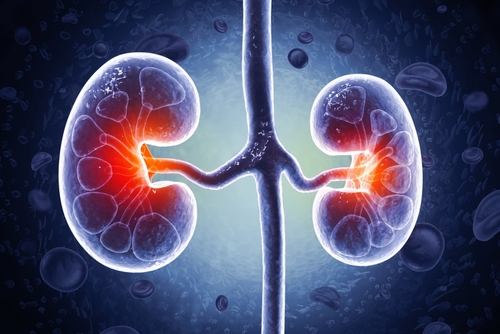
The risk of losing muscle mass is elevated in patients with chronic kidney disease (CKD) due, in part, to episodes of metabolic acidosis during disease progression, low-protein diets aiming to slow CKD progression, bone and mineral disorders, and background inflammation. Current clinical guidelines call for regular assessment of dietary protein intake; nutritional targets are designed to reduce muscle breakdown and loss.
If a patient with CKD is not losing muscle mass, they are assumed to be in neutral protein balance. A useful laboratory measure of neutral protein balance is the difference between protein (i.e., nitrogen) intake and nitrogen losses. Traditionally, the protein equivalent of nitrogen appearance (PNA) has been estimated from combined urinary and peritoneal urea losses, and it is assumed that urea represents a constant proportion of total nitrogen excreted.
However, according to Surachet Vongsanim, MD, and colleagues, depending on fluctuating acid-base balance, nitrogen excretion switches between urea and ammonia, creating the possibility that a relative increase in the proportion of nitrogen excreted as ammonia may be undetected. The result would be a false-positive nitrogen balance possibly masking concomitant muscle protein loss.
At present, there are three equations used in clinical practice to estimate PNA. Dr. Vongsanim et al. sought to determine whether there were differences in those equations in determining PNA. The researchers measured the excretion of nitrogen in urine and peritoneal dialysate effluent in the form of either urea or total nitrogen, repeating original studies but with patients undergoing modern renal therapies. Results of the cross-sectional observational cohort study were reported in the Journal of Renal Nutrition [2019;29(3):243-247].
The researchers measured urea in 24-hour collections of spent dialysate effluent using a standard laboratory analyzer (P module analyzer, Roche Integra, Roche diagnostics, Lewis, UK); total nitrogen was measured by chemiluminescence. PNA was calculated using the following equations: Bergström: 20.1 + 7.50 Urea Nitrogen Appearance g/24 hours; Randerson: 15.7 + 7.47 Urea Nitrogen Appearance g/24 hours; and Blumenkrantz: 34.6 + 5.86 Urea Nitrogen Appearance g/24 hours. Dialysate urea nitrogen was determined by adjusting for the nitrogen content of urea, 1 mol urea being equivalent to 28 g nitrogen.
Urea and total nitrogen were measured in 67 peritoneal dialysis outpatients attending for the assessment of peritoneal membrane function and dialysis adequacy. The median number of peritoneal dialysate exchanges prescribed was 5.5 per day (range, 4.0-6.0 p/d) with a median peritoneal dwell volume of 2.0 L.
Total nitrogen was greater than that for the urea nitrogen equivalent, 5.79 versus 2.66 g/day; there was a strong relationship between the two, however. The difference represents the nonurea nitrogen losses (e.g., ammonia, protein), that are ~55% of total nitrogen loss.
The regression equation derived from previous studies is used as a basis in each of the three equations to convert urea nitrogen in spent dialysate effluent to total nitrogen. In each equation, the intercept and slope of the relationship between urea and total nitrogen, including other nitrogen losses in the dialysate (an inflation factor), differed.
The researchers compared total nitrogen lost in the spent dialysates and the urea nitrogen equivalent adjusted by the individual inflation factor. There was a positive correlation with total nitrogen losses for all three equations (r=074; P<.001). There was a systematic bias for estimated total nitrogen when compared with measured total peritoneal nitrogen losses in the Bland-Altman analysis. At lower urea losses, total nitrogen loss was overestimated; at higher peritoneal urea losses, total nitrogen loss was underestimated.
There were significant differences in the difference between measured –4.1 total nitrogen and that estimated by each of the three equations: measured loss was 27.7 g per day versus Bergström, 16.5 g per day; Randerson, 16.4 g per day; and Blumenkrantz, 12.9 g per day (P<.001).
The researchers said, “Our findings demonstrate that at higher protein losses, the currently used predictive equations underestimate the amount lost. It is important to compensate the iatrogenic protein loss by recommending the appropriate intake of dietary protein to patients, in an attempt to minimize muscle wasting. This discrepancy may have arisen because of the characteristics of newer peritoneal prescriptions and change in patient demographics. We propose a new equation PNA g/day = 0.31 ´ (urea loss mmol) + 7.17, which will require prospective validation in additional studies.”
Takeaway Points
- Patients with chronic kidney disease receiving peritoneal dialysis are at increased risk for muscle wasting. Current guidelines call for assessment of dietary intake via calculating protein equivalent of nitrogen appearance (PNA) to ensure sufficient protein intake.
- Researchers conducted a cross-sectional observational cohort study to re-evaluate the three equations currently used to estimate PNA by comparing measured peritoneal nitrogen losses with the estimates as determined by the equations.
- Analysis revealed that at higher protein losses, each of the three equations underestimated protein loss.







 © 2025 Mashup Media, LLC, a Formedics Property. All Rights Reserved.
© 2025 Mashup Media, LLC, a Formedics Property. All Rights Reserved.